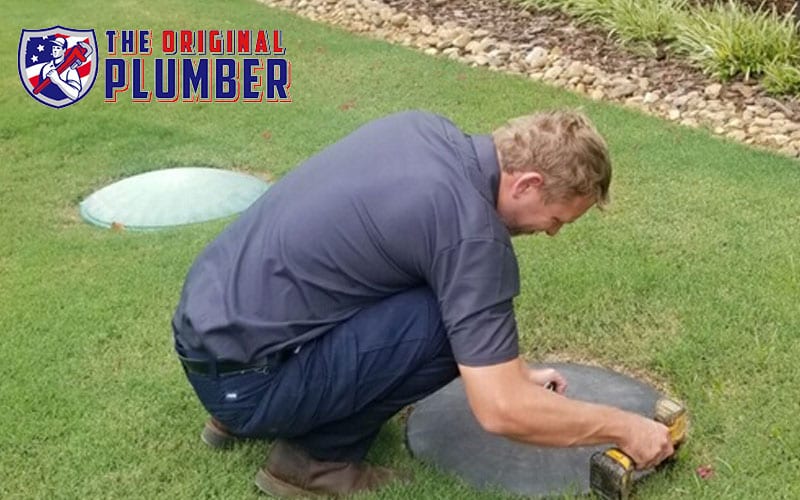If you’re like most people, you enjoy sitting out on your back patio or porch and admiring the landscape – not trying to determine where your septic tank might be located.
But knowing where your septic tank is located can make scheduling routine sewer line cleanouts and maintenance a little easier. Read on to learn more about how to find your septic tank.
Follow the Main Sewer Line
Purchase a soil probe that you can stick into the ground to find the buried sewer line and septic tank. Go to your basement or crawl space, and then look for the main sewer line that leads to your septic tank. Look for a pipe that’s roughly four inches in diameter that leads away from your house. Remember the location of the sewer pipe and where the pipe leaves your home so you can find it outside. The sewer pipes will lead to where your septic tank is located. You can also use a drain snake to try to follow the approximate route of your pipes.
Insert the thin metal probe into the soil every two feet to find and follow the sewer lines. Most states require that septic tanks sit at least five feet from the residence, with many tanks sitting 10 to 25 feet away, so you may have to probe a little further out before hitting the tank.
Inspect Your Property
Sometimes, imperfections in the landscape can tell you where your septic tank sits. Septic tanks are usually installed in such a way that you can barely tell. But dips in the soil or small hills may indicate a septic tank buried underneath.
If these dips or hills are located five to 25 feet away from your property, use your soil probe to locate the septic tank. Since most septic tanks typically sit between six inches and four feet underground, make sure you probe the soil deep enough. You want to hit something that feels hard like flat concrete or fiberglass.
As you inspect your property, you can also keep an eye out for the septic lid. You should be able to find the septic tank cover with your metal soil probe. These are typically at or just below ground level.
Your septic tank will likely not be underneath any of the following:
- Paved surfaces
- Special landscaping
- Your water well, if you have one
If you still have issues finding your septic system, you can also ask neighbors where their septic tank on their property. Knowing how far away their septic systems are can clue you into where yours may be in your yard.
Check the Property Records
Not sure how to get this? Just call your county health department! Check with your local health department to see if they have a property survey map and septic tank map.
You may be surprised to know that there are many ways you can get information about your property without ever leaving the comfort of home. The county records, for instance, often include building permits- which might contain diagrams with dimensions on how far away from a septic tank should be and other helpful tips like what size it is, etc.
Unfortunately, the property records of older homes may or may not include this information. But most counties retain records for septic tank installations for all addresses.
You can also check your home inspection paperwork, or review the house deed to find location of your septic tank.
Don’t Try to Fix Septic Tank Issues Yourself
Leave septic tank issues to the professionals. Once you locate the septic tank, contact The Original Plumber & Septic so we can perform routine maintenance or assess any issues.
Don’t open the septic tank lid as toxic fumes can cause serious health issues. Falling into an open septic tank can lead to injury or death. While it’s useful to know how to find your septic tank, it’s also useful to remain mindful of the health risks involved in opening the tank.
Schedule Septic Tank Maintenance
Regular septic tank maintenance helps prevent sewer backups and costly repairs to your sewer system. Depending on the size of your tank, and the number of people who live in your home, you should plan to have your septic tank pumped out every three to five years.
The Original Plumber & Septic provides professional septic tank and drain field maintenance and repairs. While it’s important to know the location of the septic tank, is not necessary. Our team of professional plumbers has all of the tools and equipment to find your tank, even if you have a large property.
We provide quality service to Metro Atlanta and surrounding areas. We’re open seven days a week, 24/7. We also offer emergency sewer services when you need them.
Frequently Asked Questions
What is a septic system?
A septic system is a wastewater management system. Simply put, wastewater will leave your home through pipes until it reaches your septic tank outside the home. The septic tank is typically buried underground. Inside the septic tank, solids and liquids will separate. Solids will sink to the bottom, and liquids will eventually drain out into your leach field.
How do I know if I have a septic tank?
If there are no visual clues that you may have a septic tank – such as uneven landscaping in your yard – then there are a few ways you can determine if you have a septic system.
Checking your property records is the best way to guarantee what system you’re using. A septic system map should have been included with your property records when you purchased the home.
Another way to tell is to check your utility bill. Because your septic system is part of your wastewater management, you shouldn’t have a water bill from the public utility services. You may not even receive one at all if you’re also using well water. If you don’t have a meter attached, then you have hooked up to well water rather than the public sewer system.
What do I do once I locate my septic tank?
There are a few things you should do once you locate your septic tank. Marking your septic tank’s location is important. If you ever need a sewer line cleanout or septic tank maintenance, you can save time with your inspection, pumping and repair services.
Mark the exact spot of your tank so that way, you can find it again. It should be heavy enough to not blow away in inclement weather. Using garden decor or a potted plant can be a clever way to do this without having an unsightly flag or marker in your yard!
If there was not already a septic tank map that you received when you purchased the home, you should create one. This way, you have it for future reference and can easily find the exact location again. Then, you can pass it along to the next homeowner should you ever sell the property.
Then, call The Original Plumber & Septic for routine maintenance on your septic system. Properly maintaining your septic system can help prevent larger issues and the need for repair work down the road. Our team is here to do all of the heavy lifting for you!




